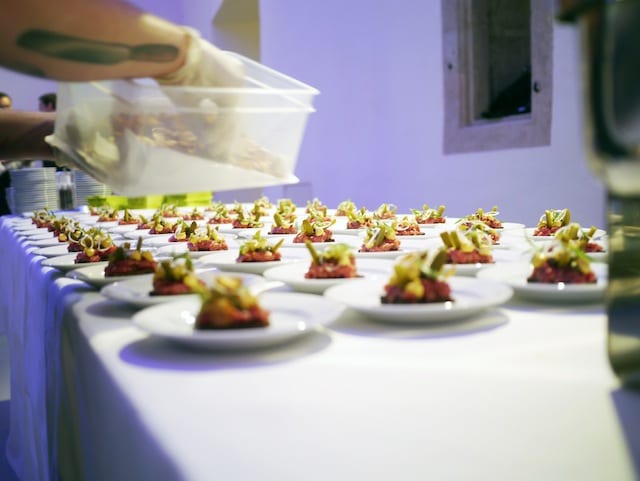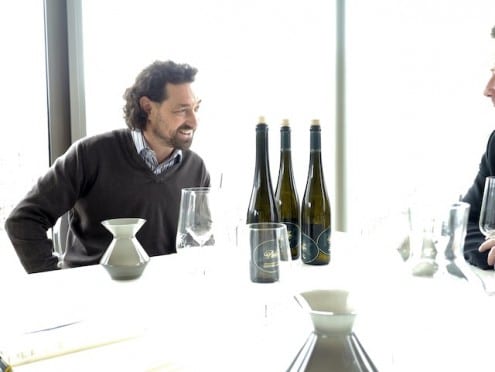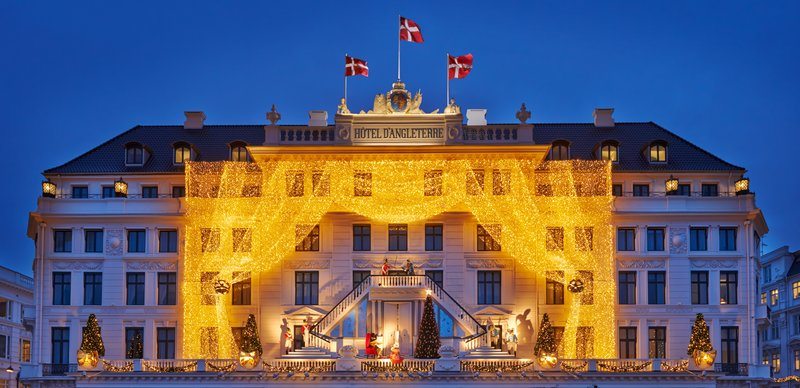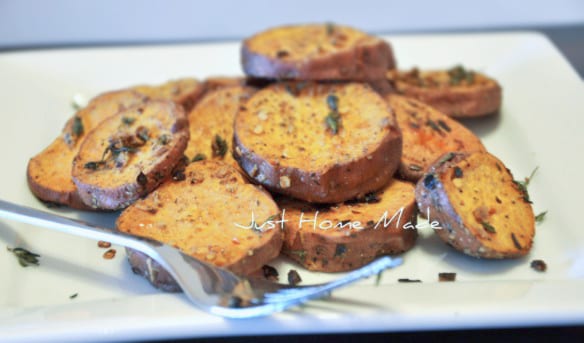Rasmus Palsgård is Danish journalist by profession living in Copenhagen.…
Wachau Gourmet Festival recently greeted two Danish star chefs to their region and paired the food with the tremendous wines from the region – a match a god worthy.
By Rasmus Palsgård
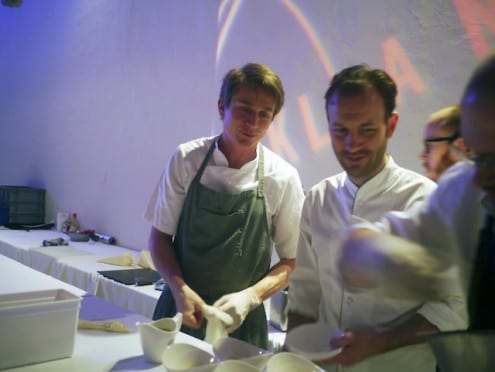
The view of runways in Vienna just switched into one of a beautiful, green landscape of mountains with the peacefully running blue water of the Danube River in between. I am sitting at the backseat of a Jaguar XJL with its voluminous front grill headed towards Wachau in Austria.
The princely vehicle approaches the hotel and after a sharp hairpin turn to the right we pass the city sign to the village Dürnstein, and 100 meters later it makes sense why the expected old Skoda Octavia is substituted with a statelier model. The chauffeur has parked in front of my accommodation, Schloss Hotel Dürnstein, finished in 1630 and today a member of Relais & Chateau – and here they bring their guests to the door in a decent way.
Schloss Hotel Dürnstein is not just any other luxury hotel. It’s named after the original Schloss Dürnstein – today a ruin due to the Thirty Years War in 1645 when the Swedes bombed the castle. In this historical scenery, the sixth edition of the Wachau Gourmet Festival has just started. And here, a special dinner is going to take place in a local church, Minoritenkirche, in the city Krems, very close to Dürnstein.
The organizers of the Wachau Gourmet Festival have flown in the New Nordic entrepreneur and noma co-founder Mads Refslund, and Adam Aamann, who has reinvented smørrebrød (Danish open sandwich). Here in the Wachau, they are going to present a combined Nordic Kitchen to the Austrians through an eight-course dinner.
But why in Wachau, you might think. Because of the Austrian’s interest in Denmark’s new culinary adventure, and the fact that the splendid white wines of the Wachau region pair extremely well with the New Nordic Cuisine’s profile, the terroir-based idea with local produce, pure flavours and a light expression, – just like it’s the case in the best wine regions in the world.
“We have invited Mads and Adam because the New Nordic Cuisine and the wines from Wachau simply is a perfect combination, and we want to show the guests in Austria the innovative style of cooking of the Nordic star chefs,” Claudia Alrichter, organizer of Wachau Gourmet Festival, says.
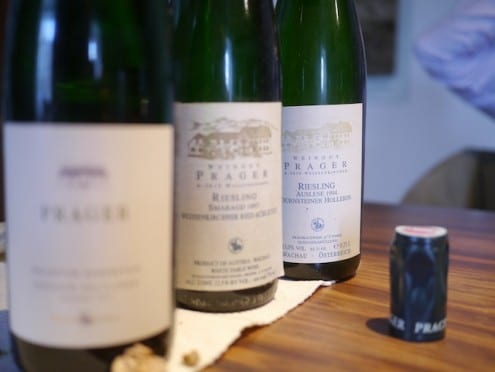

World-class Wine
The Wachau region is actually so beautiful that this area 80 kilometres west of Vienna in 2000 was admitted in the UNESCO World Heritage list in recognition of the beautiful nature, architecture and agricultural history. The Wachau reaches over 30 kilometres between the two cities Melk and Krems, and it is right here, at these mountainsides, that some of the best white wines of the world are made.
“The white wines from the Wachau are definitely some of the world’s best. It is another style than for example the grand crus in Burgundy but qualitatively the wines from the Wachau compare with the biggest French white wines”, president of the Danish sommelier association, Christian Aarø, says. He’s also the restaurateur at one Michelin starred Restaurant AOC in Copenhagen, where white wines from Wachau are often found on the menu.
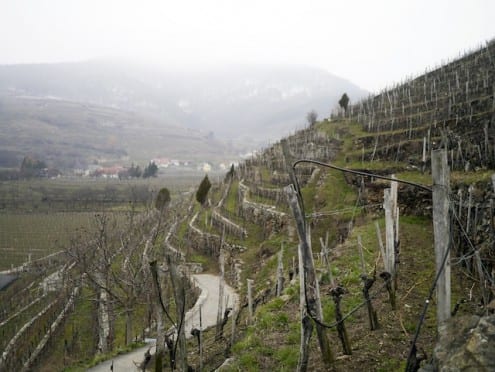
The mountainsides in Wachau are actually too steep for a winemaker to get around in. Therefore the steep sides are recognized by terraces. Weingut Hirtzberger’s exclusive vineyard Singerriedel is not just an excellent viewpoint but also a perfect example on the building of the terraces. Each row of plants is growing on flat plateaus built of rocks, so that the winegrowers more easily can walk around in the vineyards. It was Bavarian monks in the middle age, who made the terraces to start growing wine.
Because of the steepness and plateaus harvesting by machine is not possible. All grapes are being harvested manually, which is securing a higher quality through enlarged selection.
Two Varieties, Three Levels
Two green grape varieties dominate in the Wachau. The first one is Riesling, the world famous grape variety that creates some of the most beautiful and complex wines in Alsace, Mosel and Austria. The versatile profile reaches from stringent citrus fruits and crispy, green apples to tropical fruit, for example pineapple. In the Wachau, the broad fruit spectre is typically accompanied by an elegant minerality and a straight refreshing acidity that gives the Rieslings from this region a juiciness which just makes you want to take another sip. The biggest wines are extremely complex and tempting. It is exactly at these steep sides, where the soil is rich on granite, that the Riesling grape is doing well.
In the more sandy soil in the lower, flatter vineyards, the Austrian national grape, Grüner Veltliner, is delivering great results. Grüner Veltliner is a grape variety that rarely disappoints and even in the basic level wines you will experience juicy, crispy wines with a quenching effect, which makes the wines easy and delightful to drink. In the other end of the scale the best winegrowers make white wines of the Grüner Veltliner with an enormous fruit intensity, creaminess and minerality. Flavours of green apples, pears and a hint of pepper are often present in these wines. Grüner is always delivering very clean wines with a refreshing and crispy acidity.
Because of the fact that the wines are growing relatively high above sea level combined with cold and warm winds from several directions, the fluctuations are high between night and day. While the grapes are ripening and thereby developing their intense fruitiness during the day, the cold nights preserve the fine nuances and the crispy acidity in the grapes. The fluctuations ensure the balance, which is so characteristic for the wines of the Wachau region.
The Perfect Match
Back in the kitchen at Schloss Hotel Dürnstein, the last preparations for the dinner are being made.
“Try this,” Mads Refslunds says while he hands out a spoonful of fermented pear juice, which has been reduced together with chicken broth. It tastes intense, original and transcendent.
Oysters are being opened for a dish by Mads Refslund with new onions and lightly cooked trout, while Adam Aamann and his team are chopping heart of veal for an amazing tartar with beetroot and rye bread crumble.
These are just a few of the elements for the eight courses menu, which is soon going to be executed in the church in Krems.
“I seek clean taste in my dishes and my smørrebrød. I do my best to let all ingredients express themselves as much as possible without too many gimmicky techniques. The light dishes work very well together with the style of a lot of the Wachau white wines, where pure taste, minerality, crispy acidity and elegance are all very distinct,” Adam Aamann says.
Purity is significant for all dishes, where every single ingredient is able to express itself – some of the important reasons why The New Nordic Kitchen and the white wines from the Wachau fit so excellently together.
“What’s special about the wines from the Wachau is the grapes and the terroir. Those are parameters that give the fruity, mineral and slightly spicy flavours, that you often find in these wines. The wines from the Wachau region are in general of a higher quality compared to the rest of Austria and thereby the intensity is enhanced. They taste of the real deal, just like The New Nordic Cuisine,” Christian Aarø says.
The church is now full of guests and the team of chefs are working at full throttle. The guests are happy. They are taking photos of the chefs with their smartphones, while they absorb the elegant Wachau wines at a rather fast pace. They have experienced new flavours, gained insight to the mind of the Nordic chefs and discovered new possibilities regarding the pairing of food and wine. The light, feminine cuisine of Mads Refslund with the many raw components that are appearing very clearly, exemplified in a dish with slices of scallops, fresh hazelnuts and Jerusalem artichokes, is being accompanied by Adam Aamann’s impressive talent to lift the classic smørrebrød to new heights with the veal heart tartar being a brilliant example. In my glass, a crispy and juicy Riesling from the biodynamic producer Nikolaihof confirms the statement of Christian Aarø – The New Nordic Cuisine in company with the white wines of the Wachau is the real deal and worthy every single church in this world.
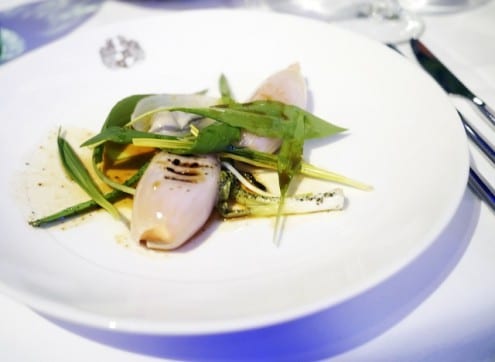
The two chefs
Mads Refslund
Mads Refslund was together with René Redzepi a part of the establishment of The New Nordic Cuisine and Noma. After closing his Michelin-restaurant MR in Copenhagen, he moved to New York, where he’s having great success as chef patron at ACME. There he uses the local ingredients in the surroundings of New York based on the New Nordic idea.
Adam Aamann
In continuation of the birth of The New Nordic Cuisine, Adam Aamann renewed the old Danish tradition smørrebrød. He introduced it in a lighter, more elegant version, which in a matter of flavour and visual expression is at a high level. You can discover smørrebrød at Aamanns Etablissement in Copenhagen, or you can go to New York, where he has now opened the first restaurant with smørrebrød on the menu in the United States.
In the Wachau, the white wines are divided into three levels according to alcohol levels and intensity:
Steinfeder is with its maximum alcohol level of 11,5 % the lightest wine. It is very fresh, crispy and has a young, charming fruitiness, that make it very suitable for light fish and seafood dishes.
Federspiel has an alcohol level from 11,5 to 12,5 %. Stylistically, it is in between the light expression and the more rich, intense and creamy one.
Smaragd is the range of wines with an alcohol level above 12,5 %. Smaragd is made from lately harvested grapes, and therefore the wines are rich, creamy and very intense on the fruit. A very mineral layer and a refreshing acidity are creating a great balance in these wines. The smaragd wines have great ageing potential and the best of them can easily age for both twenty and thirty years.
The three best producers in the Wachau
FX Pichler
”FX Pichler is the Chateau Latour, Domaine de la Romanée-Conti, Zind-Humbrecht, Sandrone and Helen Turley of the Wachau,” the world’s most powerful wine critic, Robert Parker has once said.
FX Pichler was established by Franz Xavier Pichler, and today his son Lucas is carrying on the business. FX Pichler is without any doubt the most exclusive producer in the Wachau and almost every top-level restaurant is having the wines in their cellars. The style of the producer is rich, creamy and often with an intense tropical fruit, which is balanced by a great acidity.
Weingut Prager
Toni Bodenstein is as well as an excellent wine producer mayor, public servant and a bank manager. Despite his busy everyday he certainly cares about his wines, that are very varied in their expressions.
“I seek for clearness, finesse and elegance as a reflection of the terroir. The origin of the wine shapes it so that the specific vineyard can be found in the glass,” he says.
Toni is not using sulphur in his vineyards and just very little when he bottles the wines. The result is some extremely clear and pure wines, and the small use of sulphur is not destroying the ageing potential, exemplified by his 1990 Riesling Smaragd Wachstum Bodenstein from the vineyard Ried Achleiten, which still had huge fruit intensity, lots of minerality and a present, refreshing acidity.
Weingut Hirtzberger
To be standing on the slopes in the landscape where Franz Hirtzberger is growing his wines is in itself a life-affirming experience. From here you can see the Danube River and mountains as far as the eye can see. It feels like you can taste the nature on the wines, which are lively and juicy. The balance between fruit, minerality, sweetness and acidity is always perfect in Hirtzberger’s wines.
Rasmus Palsgård is Danish journalist by profession living in Copenhagen. He is one of the leading food and wine writers in Denmark contributing to the leading media in Denmark. Rasmus Palsgård is the Danish chairman of the sustainable restaurant list 360 Eat Guide. He also a passionate home cook and in 2016, he was one single mistake away from winning the Danish edition of MasterChef.

